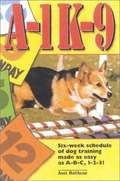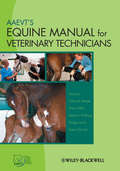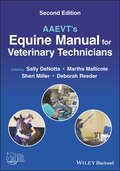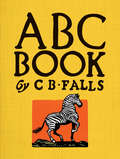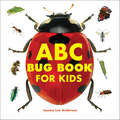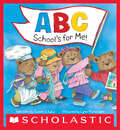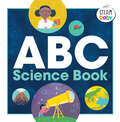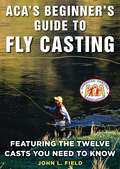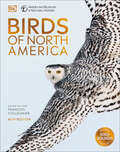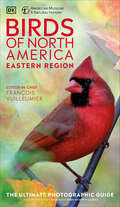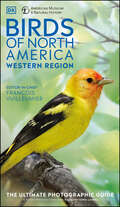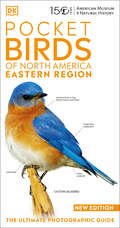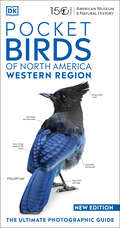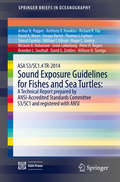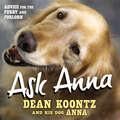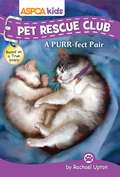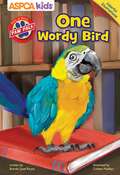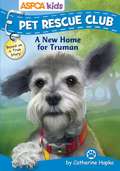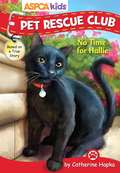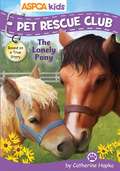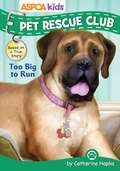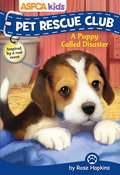- Table View
- List View
A-1 K-9 A Six-Week Schedule of Dog Training Made as Easy as A-B-C 1-2-3
by Anet HaithcoxA safe, humane method of teaching your pet basic obedience, for puppies as young as 7 weeks as well as older dogs of any age, formulated for the beginner dog.
AAEVT's Equine Manual for Veterinary Technicians
by Deborah Reeder Sheri Miller Dana Zimmel Midge Leitch Deeann WilfongAAEVT's Equine Manual for Veterinary Technicians offers a compendium of information on the care and treatment of horses for equine veterinary technicians. Highly accessible and easy to use, the book builds on the basics of equine care to provide a complete reference for equine nursing and technical skills. AAEVT's Equine Manual for Veterinary Technicians is an invaluable guide for qualified equine veterinary technicians and assistants, particularly those earning their equine certification, vet tech students, and equine practices.
AAEVT's Equine Manual for Veterinary Technicians
by Deborah Reeder Sheri Miller Sally DeNotta Martha MallicoteAAEVT’s Equine Manual for Veterinary Technicians Practical handbook on all aspects of veterinary care in horses relevant to veterinary technicians AAEVT’s Equine Manual for Veterinary Technicians, Second Edition offers a compendium of information on the care and treatment of horses for equine veterinary technicians, building on the basics of equine care to provide a complete reference for equine nursing skills, training, and technical information. The text is specifically geared toward those who already have basic equine knowledge and training and are looking to build upon their foundations. Comprehensive yet accessible, the new edition updates all medical, procedural, pharmaceutical, equipment, staffing, and office management information. Images also appear in full color throughout the book for the first time. Chapters cover a variety of topics ranging from general horse management and nutrition to diagnostics and medical emergencies. Charts, tables, and images support the text to aid in reader comprehension. Sample topics covered in AAEVT’s Equine Manual for Veterinary Technicians include: General horse management, equine nutrition, applied anatomy and physiology, equine reproduction, and equine wellness programs Foal care, equine pharmacology, laboratory diagnosis in equine practice, equine anesthesia, surgical assistance, and nursing care Technical procedures, diagnostic procedures, common equine medical emergencies, equine physical rehabilitation, equine behavior, and equine office procedures An overall explanation of procedures and medical information regarding the care of horses in a clinic or ambulatory practice Highly accessible and easy to use, AAEVT’s Equine Manual for Veterinary Technicians, Second Edition is an invaluable reference for qualified equine veterinary technicians and assistants—particularly those earning their equine certification—as well as vet tech students and equine practices.
ABC Book
by C. B. FallsThis classic primer ranges from the familiar Antelope, Bear, and Cat to more unusual creatures ― the graceful Ibis, the aquatic Newt, the legendary Unicorn, and the powerful Xiphius, better known as the swordfish. Originally published in the 1920s, this volume is graced with striking poster art images of every animal. Each letter is represented by a full-page color woodcut illustration. In addition to its value to young learners, the ABC Book will appeal to collectors, bibliophiles, and others who appreciate beautiful books.
ABC Bug Book for Kids
by Jessica Lee AndersonExplore bug facts while practicing the ABCs—for kids ages 1 to 3.From ants to zebra spiders, there's a bug for every letter of the alphabet! Meet a huge variety of our many-legged friends with this colorful book made just for toddlers. They'll dive into awesome trivia about bugs—like what they eat and where they live—all while learning their letters.The ABC Bug Book is an engrossing alphabet book, specially designed with preschoolers in mind, to help them sharpen their reading skills while learning about the fascinating world of bugs. With a plethora of fascinating facts and vibrant pictures, this children's bug book enhances their natural curiosity about these many-legged creatures. Get a preschool bug book that includes:Crawling critters from A to Z—Connect all 26 letters to different bugs to help little ones remember what they learn.Fascinating facts and pictures—Age-appropriate language and tons of vibrant photos will keep kids engaged with every page.A quiet time activity—This book is perfect for adults to read aloud, or for kids and parents to read together.Help kids learn the alphabet and get excited about nature with this big book of bugs.
ABC Dinosaurs
by Pearl RodgersIn this colourful alphabet book, intrepid explorer Erik-son joyfully befriends all the dinosaurs - from mighty T-Rexes to cheerful Ceratopsians - on an adventure to unite the feuding prehistoric beasts into one friendly, fun-loving dino family. Follow along in rhyme while Erik-son leads misunderstood Velociraptors, shy Brontosauruses, grumpy Stegosauruses and all the marvellous ABC dinosaurs on a quest to appreciate each other’s differences, forge new friendships, and learn that when dinosaur play nice together, there’s fun enough for all! Bursting with vibrant scenes of laughing, stomping, chomping dinosaurs, ABC Dinosaurs joyfully shows how understanding and positivity can bring even the most unlikely friends together.
ABC School's for Me!
by Susan B. KatzGet ready for school with this clever, rhyming alphabet story illustrated by bestselling artist Lynn Munsinger!Alphabet from A to Z.Books that are just right for me.Crayons for coloring in my hand.Dump trucks playing in the sand.Cuddle up with your little bear and enjoy this rhyming read-aloud chock-full of the ABCs of school. There's so much alphabet to explore!
ABC Science Book (STEAM Baby for Infants and Toddlers)
by Anjali JoshiABC learning through the power of S.T.E.A.M. for ages 0 to 3Give your little scientist a jump-start with this fun, inspiring way to master their ABCs. From astronaut to zoologist, ABC Science Book introduces young children, up to age 3, to basic scientific concepts and careers with each letter of the alphabet.This S.T.E.A.M.-themed ABC book for kids features:Levels of discovery—Explore a tiered learning approach that grows with your child; focus first on letters, then on words, and then on understanding concepts.Colorful images—Rich and vibrant illustrations add to the learning and keep your child engaged.Full S.T.E.A.M. ahead—Encourage a lifelong love of learning with all the books in the S.T.E.A.M. Baby series.ABC Science Book makes learning the alphabet a fun, exciting adventure for any toddler.
ABC T-Rex
by Bernard MostT-Rex loves the alphabet so much, he wants to eat it up. So he takes a bite or two, and he finds that C is chewy, D is delicious, and K tastes great with ketchup! Go out to eat with T-Rex, get a taste of this appetizing alphabet--and learn a little about food and a lot about fun! *Nearly half a million Bernard Most dinosaur books sold to date *Uses the alphabet to introduce many foods to very young children
ACA's Beginner's Guide to Fly Casting: Featuring the Twelve Casts You Need to Know
by John L. FieldIn The ACA's Beginner's Guide to Fly Casting: Featuring the Twelve Casts You Need to Know, John Field, tournament caster and FFI Master Casting Instructor, teaches and explains the fundamentals of fly casting, step by step. John shares the casting games of the American Casting Association and its 110 years of proven methods. This guide also includes learning tips from champion casters Steve Rajeff and Chris Korich. To begin, Field carefully lays out the essentials for getting ready, like assembling an outfit, and caring for your tackle. Next, he shows the simplest but most efficient way to start casting and practicing for results. Once you can make the basic cast, the next chapters provide the steps to achieve casting accuracy and distance. Whether learning to fly fish in fresh or saltwater, Field's expertise is sure to have you casting like a pro before you know it. With expert instructions, accompanying diagrams and fun drills, The ACA's Beginner's Guide to Fly Casting will help the next generation of flyfishers participate in this wonderful sport.
AMNH Birds of North America (DK North American Bird Guides)
by DKThe ultimate photographic guide to more than 650 species of bird found in North America.Ideal for the armchair bird enthusiast or dedicated bird-watcher, this beautiful bird-watching book includes stunning full-color photographs of over 650 birds, revealing each species with unrivaled clarity. A lavish introduction describes bird characteristics and behavior, while stunning full-color photographs reveal individual species for easy identification. The 550 most commonly seen birds are pictured in clear, close-up photographs, with images of similar birds provided to make differentiation easy, from game birds and waterfowl to shorebirds and swifts to owls, hummingbirds, finches, and so many more. Soar into the pages of this brilliant bird book to explore: - 650 birds species found in the United States and Canada- Bird profiles feature information on social behavior, nesting & feeding habits, and flight patterns. - Full-color photographs show the adult bird in typical plumage, with male/female, juvenile, and seasonal variations- Color-coded maps highlight resident and migratory distributions to help spotters discover which species to expect when and where-Includes bird sound audio app for mobile phone use- Produced in association with the American Museum of Natural History, one of the world&’s leading authorities on ornithologyDiscover which species to expect when and where with up-to-date, color-coded maps highlighting habitation and migratory patterns. The most commonly seen species are given a whole page in the species catalog and each full-page profile includes images of plumage variations, subspecies, information on similar birds, and artworks of the bird in flight that reveal their outstretched wings. Rare birds and vagrants who occasionally stray into North America are also described. With easy-to-read accessible information provided throughout, accompanied by beautifully large illustrations, AMNH Birds of North America is a must-have book for bird-watchers of all ages and experiences, and doubling up as the perfect bird-watching gift for the budder birder in your life.
AMNH Birds of North America Eastern (DK North American Bird Guides)
by DKEasily identify bird species west of the Great Plains with this comprehensive photographic guide.A book for avid bird watchers young and old! These pages feature high-quality photographs and full-pages details of well-known and rare species of Western North American birds, for quick and easy identification in the wild. This informative guide book profiles the extraordinary range of birds found in Western North America. The pages of the book are filled with stunning photographs and artworks of over 367 common bird species and 128 rare species seen west of the Great Plains. This field guide profiles each bird on its own page, highlighting its unique characteristics from the posture of the bird, its coloration to its flight patterns.Inside this vivid field guide, you&’ll find: • Species profile features authenticated by the American Museum of Natural History • Crystal clear photos that make birds easy to identify • Full-page profiles, access to bird sound recordings and migration maps Written by expert ornithologists in collaboration with the American Museum of Natural History, you&’ll find the most accurate and interesting facts about birds. Explore each species key behaviours such as nesting, feeding, habitat, social groupings, lifespan, and conservation status. Grab Your Field Guide And BinocularsThis bird reference book also includes the key characteristics of the sounds that birds make and includes free access to audio recordings of over 150 bird sounds. You will also be able to understand the migratory patterns of the species in the book, with accurate maps that will help you locate different species throughout the year.Complete the Series:Once you&’ve mastered Birds of North America Western, learn about these spectacular species in the Eastern and Northern regions found in AMNH Birds of North America and AMNH Birds of North America Eastern.
AMNH Birds of North America Western (DK North American Bird Guides)
by DKEasily identify bird species west of the Great Plains with this comprehensive photographic guide.A book for avid bird watchers young and old! These pages feature high-quality photographs and full-pages details of well-known and rare species of Western North American birds, for quick and easy identification in the wild. This informative guide book profiles the extraordinary range of birds found in Western North America. The pages of the book are filled with stunning photographs and artworks of over 367 common bird species and 128 rare species seen west of the Great Plains. This field guide profiles each bird on its own page, highlighting its unique characteristics from the posture of the bird, its coloration to its flight patterns.Inside this vivid field guide, you&’ll find: • Species profile features authenticated by the American Museum of Natural History • Crystal clear photos that make birds easy to identify • Full-page profiles, access to bird sound recordings and migration maps Written by expert ornithologists in collaboration with the American Museum of Natural History, you&’ll find the most accurate and interesting facts about birds. Explore each species key behaviors such as nesting, feeding, habitat, social groupings, lifespan, and conservation status. Grab Your Field Guide And BinocularsThis bird reference book also includes the key characteristics of the sounds that birds make and includes free access to audio recordings of over 150 bird sounds. You will also be able to understand the migratory patterns of the species in the book, with accurate maps that will help you locate different species throughout the year.Complete the Series:Once you&’ve mastered Birds of North America - Western Region, learn about these spectacular species in the Eastern and Northern regions found in AMNH Birds of North America and AMNH Birds of North America - Eastern Region.
AMNH Pocket Birds of North America Eastern Region
by DKThe ultimate pocket-sized guide to more than 300 feathered residents of North America&’s Eastern Region. Whether you are a budding bird-watcher hoping to find species in woodland or someone curious about the feathered visitors in your own backyard, find out everything there is to know about your favorite feathered friends, with this pocket-sized guide to many of the birds found in North America&’s Eastern Region.Compact and easy-to-use, this stunning field guide is perfect for any bird and birding enthusiast, regardless of age or level of experience. High-quality photographs bring the bird species most commonly seen west of the Great Plains to life on the page, capturing their beauty and making identification quick and effortless. Significant differences in plumage variation between juvenile and adult, male and female, and winter and summer are clearly pictured.Soar into the pages of this beloved book on birds to discover:- Detailed bird profiles include information on behavior, habits, and flight patterns to ensure accurate identification.- Covers 370 species commonly seen in the Eestern region of North America.- Full-color photographs show the adult bird in typical plumage, with male/female, juvenile, and seasonal variations included as appropriate.- Detailed illustrations show typical plumage and posture in flight.- Maps accurately locate where the bird can be seen in summer, in winter, all year round, and on migration.- Includes free access to audio recordings of bird songs and calls to aid identification. Ideal for the dedicated bird-watcher, this beautiful bird-watching book includes stunning full-color photographs of over birds, revealing each species with unrivaled clarity. The reference pages pack in more data with lists of record breakers and endangered species, as well as many other fun facts. The Pocket Genius series is perfect for all children, whether they are learning about birds or are amateur bird spotters already! Produced in collaboration with the American Museum of Natural History, Pocket Birds of North America Eastern Region is an essential field guide for identifying birds in North America.
AMNH Pocket Birds of North America Western Region
by DKThe ultimate pocket-sized guide to more than 400 feathered residents of North America&’s Western Region. Whether you are a budding bird-watcher hoping to find species in woodland or someone curious about the feathered visitors in your own backyard, find out everything there is to know about your favorite feathered friends, with this pocket-sized guide to many of the birds found in North America&’s Western Region.Compact and easy-to-use, this stunning field guide is perfect for any bird and birding enthusiast, regardless of age or level of experience. High-quality photographs bring the bird species most commonly seen west of the Great Plains to life on the page, capturing their beauty and making identification quick and effortless. Significant differences in plumage variation between juvenile and adult, male and female, and winter and summer are clearly pictured.Soar into the pages of this beloved book on birds to discover: - Detailed bird profiles include information on behavior, habits, and flight patterns to ensure accurate identification.- Covers 420 species commonly seen in the western region of North America.- Full-color photographs show the adult bird in typical plumage, with male/female, juvenile, and seasonal variations included as appropriate.- Detailed illustrations show typical plumage and posture in flight.- Maps accurately locate where the bird can be seen in summer, in winter, all year round, and on migration.- Includes free access to audio recordings of bird songs and calls to aid identification.Ideal for the dedicated bird-watcher, this beautiful bird-watching book includes stunning full-color photographs of over birds, revealing each species with unrivaled clarity. The reference pages pack in more data with lists of record breakers and endangered species, as well as many other fun facts. The Pocket Genius series is perfect for all children, whether they are learning about birds or are amateur bird spotters already! Produced in collaboration with the American Museum of Natural History, Pocket Birds of North America Western Region is an essential field guide for identifying birds in North America.
ASA S3/SC1.4 TR-2014 Sound Exposure Guidelines for Fishes and Sea Turtles: A Technical Report Prepared By Ansi-accredited Standards Committee S3/sc1 And Registered With Ansi (SpringerBriefs in Oceanography)
by Arthur N. Popper Richard R. Fay Anthony D. Hawkins David A. Mann Soraya Bartol Thomas J. Carlson Sheryl Coombs William T. Ellison Roger L. Gentry Michele B. Halvorsen Svein Løkkeborg Peter H. Rogers Brandon L. Southall David G. Zeddies William N. TavolgaThis Technical Report presents the outcome of a Working Group that was established to determine broadly applicable sound exposure guidelines for fishes and sea turtles. After consideration of the diversity of fish and sea turtles, guidelines were developed for broad groups of animals, defined by the way they detect sound. Different sound sources were considered in terms of their acoustic characteristics and appropriate metrics defined for measurement of the received levels. The resultant sound exposure guidelines are presented in a set of tables. In some cases numerical guidelines are provided, expressed in appropriate metrics. When there were insufficient data to support numerical values, the relative likelihood of effects occurring was evaluated, although the actual likelihood of effects depends on the received level. These sound exposure guidelines, which are based on the best scientific information at the time of writing, should be treated as interim. The expectation is that with more research the guidelines can be refined and more cells in the tables completed. Recommendations are put forward defining the research requirements of highest priority for extending these interim exposure guidelines
ASK ANNA
by Dean Koontz Anna KoontzBetween the pages of ASK ANNA, you'll find advice better than a belly rub. Dogs everywhere run to Anna with their questions about love, food, proper etiquette in the dog park, sibling rivalry, how to cope with lazy owners and a myriad of other topics. , and Anna's advice solves all problems and Brighten Every Dog's Day. Anna begins her counseling by putting dogs at ease. Her motto: " Let Me Hold Your Paw and Help." Anna' advice to owners is: "Read this book and get a clue about what your dogs really think of you!" Here's a special message from Anna: Dear Person, My dad, Dean Koontz, is a writer, as you might be aware. For years his first golden retriever, Trixie, also wrote books, which sometimes made the best-seller list. I vowed never to be a writer. I barely have enough time for all the belly rubs, ball chasing, bird chasing, tug-of-war, and posing cutely that is required of me as a golden retriever, not to mention all of my non-professional interests, such as the new translation of Proust that I have undertaken, and learning to pilot a hot-air balloon.Nevertheless, I have written a book of advice for dogs. It's not a matter of ego, which anyone who knows a golden retriever will attest. It's not about money, because all the earnings I receive from ASK ANNA will be given to Canine Companions for Independence, which provides assistance dogs for people with disabilities. What it's about is giving back to my community--which I feel obliged to do especially because of all the park grass I've ruined with little round brown spots. Thank you for your support.
ASPCA Kids: A Purr-fect Pair (Pet Rescue Club #7)
by Steven James Dana Regan Rachael UptonThis is the seventh book in the Pet Rescue Club series.Welcome to the Pet Rescue Club! The series begins when Janey starts a blog where people can share cute pet photos and stories. She never imagined she’d receive a heartbreaking photo of a skinny, abandoned dog. She calls on her friends Lolli, Zach, and Adam to help—and that’s just the start! When these animal-loving fourth graders discover how many animals need help in their suburban hometown, they can’t just sit by and do nothing… In volume 7, the Third Street Shelter is at capacity…with lots and lots of cats! Luckily, Janey, Lolli, Adam, and Zach are on the case! They all must work together to find loving homes for as many cats and kittens as they can. Will the Pet Rescue Club find a way to help? Read along to find out if they find a few purr-fect pairs! Read a book and help save a life: 5-7% of the purchase price of every ASPCA® (American Society for the Prevention of Cruelty to Animals) Pet Rescue Club book goes directly to the ASPCA® so they can continue their mission of helping the helpless, with a minimum donation of $50,000 through December 2019.
ASPCA PAW Pals: Chance's Choice (PAW Pals)
by Brenda Scott RoyceDive into a paw-some adventure about dogs on the job in the first installment of the Pets At Work (PAW) series!Meg Harper has moved more times than she can count, and this year is no different. She’s tired of being the new kid, and because of her epilepsy, she’s tired of being the sick kid. When a scruffy dog is abandoned at her uncle’s pet grooming salon, Meg and her cousin, Amanda, vow to work with their local shelter to find the collie a good home, giving him a second chance. But when “Chance” comes to Meg’s rescue when she experiences a seizure, Meg wonders if he could become an assistance dog—a Pet At Work—the question is...for whom? Find out who saves who in this illustrated chapter book about amazing animals!
ASPCA PAW Pals: One Wordy Bird (PAW Pals)
by Brenda Scott RoyceJoin the members of Project PAW (Pets at Work) in another paw-some adventure!The members of Project PAW (Pets At Work), Meg, Amanda, Blanca, and Drew are busy spreading the word about the amazing abilities of working animals! After Meg and her seizure-response dog, Chance, deliver a presentation at the local library, the group learns that kids who have difficulty reading show more confidence when reading to a pet. Project PAW is determined to find a shelter dog that could become a reading companion for the library, but what if their best pick for pet isn’t the furry friend they imagined? Find out in this illustrated chapter book fit for pet lovers!
ASPCA Pet Rescue Club: A New Home For Truman
by Catherine Hapka Dana ReganWelcome to the Pet Rescue Club! When Janey starts a blog where people can share cute pet photos and stories, she never imagines she'll receive a heartbreaking photo of a skinny, abandoned dog. She calls on her friends Lolli, Zach, and Adam to help - and that's just the start! When these animal-loving fourth graders discover how many animals need help in their suburban hometown, they can't just sit by and do nothing...Animal-crazy Janey can't have any pets of her own because of her father's severe allergies. Her overly-indulgent parents try to make it up to her by giving her everything else she wants, including the latest model tablet computer. So Janey uses the tablet to create a blog where kids can post cute photos of their dogs and cats. But then someone sends in a heartbreaking picture of a skinny dog. Janey isn't sure what to do, so her friends Lolli and Adam get involved to try to help the poor creature. They also enlist hyper Zach from their class at school. He might be annoying, but his mom is a vet who works with the local animal shelter. Can the four of them save the dog - and maybe start a pet rescue club to help other animals in need? Based on the real-life dog named Harry Truman adopted from the ASPCA. See Harry Truman's sweet photo and read about his heart-warming story on the bookmark included with every book! Read a book and help save a life:4%-5% of the purchase price of every Pet Rescue club book goes directly to the ASPCA® so they can continue their mission of helping the helpless.
ASPCA Pet Rescue Club: No Time for Hallie
by Catherine Hapka Dana ReganWelcome to the Pet Rescue Club! When Janey starts a blog where people can share cute pet photos and stories, she never imagines she'll receive a heartbreaking photo of a skinny, abandoned dog. She calls on her friends Lolli and Adam to help - and that's just the start! When these animal-loving fourth graders discover how many animals need help in their suburban hometown, they can't just sit by and do nothing...Zach's neighbors just had a new baby - and now they're threatening to take their cat, Hallie, to the animal shelter! The kids have been volunteering there since starting the Pet Rescue Club, and they know an older cat might have trouble getting adopted. Can they convince the family to give their kitty another chance - or maybe find someone who truly appreciates all that an older kitty has to offer? It won't be easy, especially since Janey is distracted by a lost pet bird and Lolli by a sad classmate . . . Based on a real-life cat named Hallie. See Hallie's sweet photo and read about her heart-warming adoption story on the bookmark included with every book! Read a book and help save a life:4%-5% of the purchase price of every Pet Rescue club book goes directly to the ASPCA® so they can continue their mission of helping the helpless.
ASPCA Pet Rescue Club: The Lonely Pony
by Catherine Hapka Dana ReganWelcome to the Pet Rescue Club! When Janey starts a blog where people can share cute pet photos and stories, she never imagined she'd receive a heartbreaking photo of a skinny, abandoned dog. She calls on her friends Lolli, Zach, and Adam to help - and that's just the start! When these animal-loving fourth graders discover how many animals need help in their suburban hometown, they can't just sit by and do nothing...While out walking a dog one day, Adam notices a shaggy, tiny pony standing alone in a field. Each day he sees the same lonely pony. Has she been abandoned? Looks like another case for the Pet Rescue Club! Will Adam, along with his friends Janey, Lolli, and Zach find a way to help? Read a book and help save a life:4%-5% of the purchase price of every Pet Rescue club book goes directly to the ASPCA® so they can continue their mission of helping the helpless.
ASPCA Pet Rescue Club: Too Big to Run
by Catherine Hapka Dana ReganWhen Janey starts a blog where people can share cute pet photos and stories, she never imagined she'd receive a heartbreaking photo of a skinny, abandoned dog. She calls on her friends Lolli, Zach, and Adam to help - and that's just the start! When these animal-loving fourth graders discover how many animals need help in their suburban hometown, they can't just sit by and do nothing...Zach's mom has a new patient--a giant dog named Millie who has been helping her owner train for a marathon. Millie's knees can't handle all that running and now she needs an expensive operation! Time for the kids in the Pet Rescue Club to help! Together they find a way to help Millie. Read a book and help save a life:4%-5% of the purchase price of every Pet Rescue club book goes directly to the ASPCA® so they can continue their mission of helping the helpless.
ASPCA kids: A Puppy Called Disaster
by Rose HapkinsA tornado strikes town! And Janey worries about her friends, her neighbors, and the Third Street Pet Shelter. The shelter is intact, but overflowing with animals separated from their owners and in desperate need of some help! Time for the Pet Rescue Club to pitch in! When Janey starts a blog where people can share cute pet photos and stories, she never imagined she'd receive a heartbreaking photo of a skinny, abandoned dog. She calls on her friends Lolli, Zach, and Adam to help - and that's just the start! When these animal-loving fourth graders discover how many animals need help in their suburban hometown, they can't just sit by and do nothing. The shelter is at capacity and supplies are running low. Can Janey, Zach, Lolli, and Adam help find more room and food for all the pets in need? And will they ever find the owner of the nameless tiny puppy found wandering through town? Quick thinking and teamwork help save the day in this story that helps teach kids emergency preparedness and shows that kids can make a difference in the world around them! Read a book and help save a life:4%-5% of the purchase price of every Pet Rescue club book goes directly to the ASPCA®, with a minimum donation of $25,000 through December 2017
